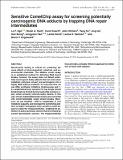| dc.contributor.author | Ngo, Le P | |
| dc.contributor.author | Owiti, Norah A | |
| dc.contributor.author | Su, Yang | |
| dc.contributor.author | Ge, Jing | |
| dc.contributor.author | Han, Jongyoon | |
| dc.contributor.author | Samson, Leona D | |
| dc.contributor.author | Engelward, Bevin P | |
| dc.date.accessioned | 2020-04-23T11:25:59Z | |
| dc.date.available | 2020-04-23T11:25:59Z | |
| dc.date.issued | 2019-12-11 | |
| dc.identifier.issn | 0305-1048 | |
| dc.identifier.issn | 1362-4962 | |
| dc.identifier.uri | https://hdl.handle.net/1721.1/124825 | |
| dc.description.abstract | Genotoxicity testing is critical for predicting adverse effects of pharmaceutical, industrial, and environmental chemicals. The alkaline comet assayis an established method for detecting DNA strandbreaks, however, the assay does not detect potentially carcinogenic bulky adducts that can arise whenmetabolic enzymes convert pro-carcinogens into ahighly DNA reactive products. To overcome this, weuse DNA synthesis inhibitors (hydroxyurea and 1-β-d-arabinofuranosyl cytosine) to trap single strandbreaks that are formed during nucleotide excision repair, which primarily removes bulky lesions. In thisway, comet-undetectable bulky lesions are convertedinto comet-detectable single strand breaks. Moreover, we use HepaRG™cells to recapitulatein vivometabolic capacity, and leverage the CometChip platform (a higher throughput more sensitive comet as-say) to create the ‘HepaCometChip’, enabling the detection of bulky genotoxic lesions that are missed bycurrent genotoxicity screens. The HepaCometChip thus provides a broadly effective approach for detection of bulky DNA adducts. | en_US |
| dc.description.sponsorship | National Institute of Environmental Health Sciences (Grant R44 ES024698) | en_US |
| dc.description.sponsorship | National Institute of Environmental Health Sciences (Grant R44 ES021116) | en_US |
| dc.description.sponsorship | National Institute of Environmental Health Sciences (Grant R01 ES022872) | en_US |
| dc.description.sponsorship | Massachusetts Institute of Technology. Center for Environmental Health Sciences (Grant P30 ES002109) | en_US |
| dc.description.sponsorship | National Institute of Environmental Health Sciences. Superfund Basic Research Program (Grant P42 ES027707) | en_US |
| dc.language.iso | en | |
| dc.publisher | Oxford University Press (OUP) | en_US |
| dc.relation.isversionof | 10.1093/nar/gkz1077 | en_US |
| dc.rights | Creative Commons Attribution 4.0 International license | en_US |
| dc.rights.uri | https://creativecommons.org/licenses/by/4.0/ | en_US |
| dc.source | Nucleic Acids Research | en_US |
| dc.subject | Genetics | en_US |
| dc.title | Sensitive CometChip assay for screening potentially carcinogenic DNA adducts by trapping DNA repair intermediates | en_US |
| dc.type | Article | en_US |
| dc.identifier.citation | Ngo, Le P. et al. “Sensitive CometChip assay for screening potentially carcinogenic DNA adducts by trapping DNA repair intermediates.” Nucleic Acids Research 48 (2020): e13 © 2020 The Author(s) | en_US |
| dc.contributor.department | Massachusetts Institute of Technology. Department of Biological Engineering | en_US |
| dc.contributor.department | Massachusetts Institute of Technology. Department of Biology | en_US |
| dc.contributor.department | Massachusetts Institute of Technology. Department of Electrical Engineering and Computer Science | en_US |
| dc.relation.journal | Nucleic Acids Research | en_US |
| dc.eprint.version | Final published version | en_US |
| dc.type.uri | http://purl.org/eprint/type/JournalArticle | en_US |
| eprint.status | http://purl.org/eprint/status/PeerReviewed | en_US |
| dc.date.updated | 2020-03-05T18:17:55Z | |
| dspace.date.submission | 2020-03-05T18:17:57Z | |
| mit.journal.volume | 48 | en_US |
| mit.journal.issue | 3 | en_US |
| mit.license | PUBLISHER_CC | |
| mit.metadata.status | Complete | |
